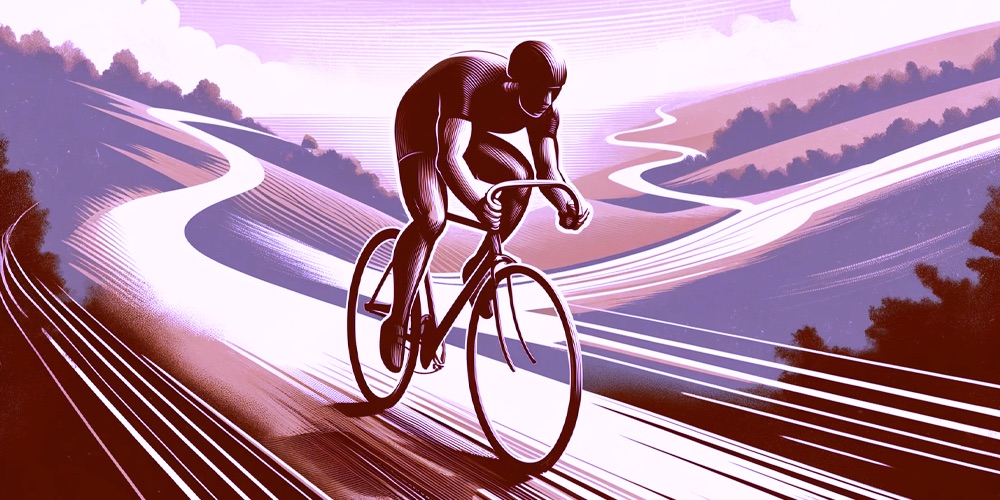One of the most exciting experiences of cycling is the feeling of speed and freedom you get when you hurtle down a road on your bike. But downhill rides are more than just adrenaline rushes: they also require technique, practice and risk awareness. Here are five tips for tackling descents with style and safety.
1. Maintain the correct position
Maintaining a good position on the bike is crucial for improving control. The body should be positioned so that the centre of gravity is as centred as possible between the two wheels, or at most slightly shifted forward. A position that is too far back reduces the weight on the steering and decreases the grip of the front wheel, while a position that is too far forward makes cornering more difficult and causes instability in the rear. Balance and a low position are therefore crucial.
If you use a road bike, placing your hands on the lower part of the handlebars helps keep your centre of gravity closer to the ground. This distributes weight better between the front and rear wheels, improving traction, especially when braking and cornering. In addition, the low grip gives greater stability, preventing surprises in case of unexpected bumps. This way, you can apply more force to the brake lever, allowing for more effective braking.
With your hands on the lower part of the handlebars, lower your body, bend your elbows and keep them close to your body, turning your chin towards the handlebars to optimise aerodynamics. Stay relaxed instead of contracting your muscles: this position will allow you to cope best on most descents.
2. Choose the right tyre pressure
Determining the correct tyre pressure is a subjective choice, influenced by various elements such as the type of bike, type of tyre, weight of the rider and load, etc. However, cyclists rarely deviate from the recommended pressures. A good starting point is to follow the tyre manufacturer’s recommendations and then test on familiar routes, increasing or decreasing the pressure until you find the level that offers greater safety.
A common mistake is to overinflate tyres, thinking that this will improve pedalling. In reality, this can have the opposite effect, reducing pedalling efficiency and decreasing grip on descents due to the reduced contact surface with the asphalt.
For rainy days, a good trick is to reduce the pressure by 2 to 3 tenths of the usual pressure. This trade-off in ride quality increases the contact surface, offering greater safety on slippery roads.
3. Learning your braking technique
When descending, the concern of not being able to stop the bike as speed increases can be very stressful. In this case, learning the right braking technique can help. However, before learning the technique, it is important to keep the brakes in good condition and check them regularly before a steep descent.
Brake firmly when necessary, and avoid continually dragging the brakes on long descents, as this can cause problems such as excessive wear on the brakes and rims. Always keep your fingers on the brake levers to be able to react quickly to any emergencies. When braking, gradually apply more or less pressure depending on the speed and angle of the bend, concentrating more on the front brake for more stopping power. Sit back and keep a light tension in your arms to stabilise your braking.
When you reach the entry point of the curve, gradually release the brakes and lean your bike towards the inside of the curve. Avoid continuing to brake during the curve unless it is strictly necessary to maintain control. Always anticipate your actions and reduce your speed before entering a curve, and avoid sudden braking during the curve.
4. Controlling the lean angle
The inclination of the bike is a key aspect of maintaining control and stability during the descent. When preparing for a turn, push the outer pedal down (the left pedal for a right-hand bend) while putting pressure on that foot. To start the curve, lean the bike in the same direction as the curve. This allows you to maintain a more stable trajectory and maximise the tyres’ grip on the road.
Be prepared to adapt the bike’s lean angle according to the curve and speed. In general, the tighter the curve and the faster you go, the greater the lean angle must be to maintain the desired line. Use your body weight slightly to lean or balance the bike. Shifting your weight using your hips is a good method for tackling a tight curve.
It is important not to overdo the lean, as this can lead to a loss of control or skidding during the descent. Take extra precautions if the road is wet: increase your braking distance, reduce your speed and lean, and maintain a more upright posture rather than sitting low on the handlebars.
5. Look ahead and anticipate
Finally, when facing a downhill bike ride, it is essential to anticipate what you will encounter along the way. Keep your gaze up and look far ahead to anticipate turns and spot any obstacles on the road. Look about 50-100 metres ahead of you to react quickly to potholes, debris, branches, cars, cyclists and avoid them. Focus on where you want to go, always keeping control of the situation.
Create with 2PEAK a triathlon, cycling, and running training plan based on artificial intelligence that adapts to your performance after each workout. Download the app and start revolutionizing your training.


